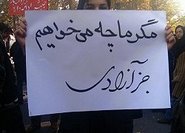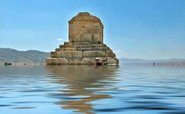When we went into Iraq, the spooks and diplomats argued repeatedly that the Iranians were not acting against us, only to discover that they were in fact up to their necks in Coalition blood.A new Pentagon report has concluded that Iran continues to provide money, training, and weapons to Shiite militias in Iraq, although U.S. commanders previously stated that attacks using lethal bombs linked to Iran have fallen in recent months."There has been no identified decrease in Iranian training and funding of illegal Shi'a militias in Iraq," the report, released yesterday, said."Tehran's support for Shi'a militant groups who attack Coalition and Iraq forces remains a significant impediment to progress," it said, adding that Iran's Revolutionary Guard Corps provides "many of the explosives and ammunition used by these groups."The Pentagon's report could hardly have been more specific: there is no convincing evidence of an Iranian cutback in support for terrorists in Iraq. So why have the attacks, and the lethality of those attacks, been reduced?It's because security forces, both the Coalition's and the Iraqis', are more effective than they were a few months ago. Most casualties have been caused by Iranian-made explosives known as explosively formed projectiles, or EFPs, and we've gotten better at stopping them. As the Pentagon report puts it:"This reduction may be attributed to effective interdiction of EFP networks, death or capture of EFP facilitators, seizure of caches and other factors." In short, things are getting better in Iraq, but no thanks to the mullahs, who continue to do their damnedest to kill us and our allies. Later on, Defense Secretary Gates moderated the language of the report saying "the jury is out" on whether or not Iran has done anything helpful.This apparently did not sit well, either at Foggy Bottom or over on 15th Street, where the Postniks conduct their operations. They struck back on the front page on Sunday with an interview with the State Department's senior top official on Iraq, David Satterfield:"The Iranian government has decided 'at the most senior levels' to rein in the violent Shiite militias it supports in Iraq, a move reflected in a sharp decrease in sophisticated roadside bomb attacks over the past several months …"Tehran's decision does not necessarily mean the flow of those weapons from Iran has stopped, but the decline in their use and in overall attacks 'has to be attributed to an Iranian policy decision,' Mr. Satterfield said in an interview."Mr. Satterfield's argument seems to be based on logical inference rather than on hard evidence, which in this case would be hard to come by, and which our ambassador in Baghdad, Ryan Crocker, doesn't seem to share. "I am real modest about what I think I understand on Iranian actions, decisions and motivations," Mr. Crocker told the Post, which is pretty much what Mr. Gates said as well.Mr. Satterfield's argument might be more convincing if our intelligence community and diplomatic corps had been consistently accurate in evaluating Iran's actions over the course of the war. But, in practice, they have often been surprised. During the fighting in Afghanistan, they thought the Iranians were being helpful, only to learn that at the same time the mullahs were making nice at the conference table, they were training and arming assassins operating against us on the battlefield.When we went into Iraq, the spooks and diplomats argued repeatedly that the Iranians were not acting against us, only to discover that they were in fact up to their necks in Coalition blood. And the best that can be said about their assessments of Iran's nuclear program is that they expressed high confidence in 2005 that Iran was trying to make nukes, and two years later expressed high confidence that Iran had stopped trying. Meanwhile, our neighbors to the north have no doubt about Iran's campaign against NATO forces in Afghanistan. During a Christmas visit to Canadian troops, Canada's defense minister, Peter MacKay said that weapons are flowing from Iran into the hands of Afghan insurgents, and he doesn't like it. Those Iranian-made weapons account for the bulk of Canadian deaths and casualties.The one case in which we can be reasonably certain that Iran has reined in killers in that part of the world is the Mahdi Army of Moqtadah al Sadr. A good four months ago, Mr. Sadr called on his followers to stand down during the American surge. Not everyone heeded his call--his movement has splintered over the past year--but there was a significant falloff in the tempo of their attacks. It's hard to imagine this could have happened without Tehran's approval as Mr. Sadr's weapons and funding come in large part from Iran. That's pretty easy to see, but the sort of case Mr. Satterfield is trying to make, in the teeth of statements to the contrary from the men and women actually fighting this war, sounds more like wish fulfillment than serious analysis.And as luck would have it, the Post/Satterfield page one story fits perfectly with the desires of the secretary of state, who keeps on saying she wants to negotiate a happy ending to our longstanding troubles with Iran.It won't work. And it's no accident that the soldiers--who have begun to bring decent security to most of Iraq--understand the situation far better than the diplomats and spooks who have nothing to show for years of negotiations.
Michael A. Ledeen is a resident scholar at AEI.
Flying Humans, Hoping to Land With No Chute : By MATT HIGGINS



Jeb Corliss wants to fly — not the way the Wright brothers wanted to fly, but the way we do in our dreams. He wants to jump from a helicopter and land without using a parachute. And his dream, strange as it sounds, is not unique. Around the globe, Mr. Corliss said, at least a half-dozen groups — in France, South Africa, New Zealand, Russia and the United States — have the same goal in mind. Although nobody is waving a flag, the quest has evoked the spirit of nations’ pursuits of Everest and the North and South Poles.
“All of this is technically possible,” said Jean Potvin, a physics professor at Saint Louis University and a skydiver who does parachute research for the Army. But he acknowledged a problem: “The thing I’m not sure of is your margins in terms of safety, or likelihood to crash.”Loïc Jean-Albert of France, better known as Flying Dude in a popular YouTube video, put it more bluntly: “You might do it well one time and try another time and crash and die.”The landing, as one might expect, poses the biggest challenge, and each group has a different approach. Most will speak in only the vaguest terms out of fear that someone will steal their plans.Mr. Corliss will wear nothing more than a wing suit, an invention that, aeronautically speaking, is more flying squirrel than bird or plane. He plans to land on a specially designed runway of his own design. It will borrow from the principles of Nordic ski jumping and will cost about $2 million, which explains why he is so much more vocal than the others about his quest. Mr. Jean-Albert figures he could glide to a stop on a snowy mountainside. “The basic idea is getting parallel to the snow so we don’t have a vertical speed at all, there is no shock, and then slide,” he said.Then there is Maria von Egidy, a wing suit maker from South Africa, who said she had begun creating a suit that would allow pilots to land on their feet on a horizontal surface. “I think people will recognize this makes sense,” said Ms. von Egidy, who has been pursuing financing for her suit. “Why didn’t someone think of this long ago? I’m hoping that will be the reaction.”That depends on whom you talk to — the endeavor is either quixotic or brave. Even Evel Knievel had the sense to pack a parachute when he climbed into his Skycycle X-2 to jump Snake River Canyon in 1974. This spring, Mr. Corliss will attempt the first of three tests to prepare for his goal. Wearing his wing suit, he will jump from a plane, which will then execute a 270-degree turn and descend at a steep angle. He will fly down to the plane and re-enter it. This will be his second attempt at the benchmark. His first failed when he missed the plane; he deployed his parachute and glided to earth.“The plane was flying too fast,” said Mr. Corliss, who gained a degree of notoriety in April 2006 when the police arrested him after he was stopped from jumping off the Empire State Building’s observation deck. A judge dismissed the charges. Wing suits are not new; they have captured the imagination of storytellers since man dreamed of flying. From Icarus to Wile E. Coyote, who crashed into a mesa on his attempt, the results have usually been disastrous. But the suits’ practical use began to take hold in the early 1990s, when a modern version created by Patrick de Gayardon improved safety. Modern suit design features tightly woven nylon sewn between the legs and between the arms and torso, creating wings that fill with air and create lift, allowing for forward motion and aerial maneuvers while slowing descent. As the suits, which cost about $1,000, have become more sophisticated, so have the pilots. The best fliers, and there are not many, can trace the horizontal contours of cliffs, ridges and mountainsides. “Wing-suit flying totally changes the way you fly and you jump,” said Mr. Jean-Albert, who is seen in his YouTube video skimming six feet above skiers in the Swiss Alps. “It creates a third dimension because in normal skydiving your trajectories are pretty vertical.”Some wing suit pilots have briefly slowed the vertical descent to about 30 miles an hour. But they are moving forward horizontally at 75 m.p.h. Even if a pilot could achieve such speeds, Mr. Potvin said, any slight wrong movement could cause a crash and certain death.Mr. Corliss said he could land safely at about 120 m.p.h. To protect his neck, he said, he will attach his helmet to a rigid-framed exoskeleton with the wing suit.“Is there some crazy person out there who might beat me because he’s willing to do something more dangerous than me?” Mr. Corliss, 31, said by telephone from his home in Malibu, Calif. “Yes, but I’m not that guy.”Mr. Corliss has plenty of experience jumping from high places. A BASE jumper — someone who leaps from buildings and cliffs and lands with a parachute — he has made more than 1,000 jumps, including from the Eiffel Tower and the Golden Gate Bridge.He was encouraged by the response to his plans from Vertigo, an aerospace company in Lake Elsinore, Calif., that has worked on projects for NASA and the United States military.“Is it possible?” said Roy Haggard, a founder of Vertigo and a skydiver himself. “Yeah.”Mr. Haggard had a plan similar to Mr. Corliss’s, but he said he had neither the time nor the money to pursue it. If Mr. Corliss can raise enough money, Mr. Haggard’s company will help him design and build the runway.“Everybody wants to be the first one to do it,” Mr. Haggard said.Which leads to an obvious and inevitable question: Why?“Because everybody thinks that it’s not possible,” Mr. Corliss said. “The point is to show people anything can be done. If you want to do amazing things, then you have to take amazing risks.”
I caught a segment during this morning's "Today Show" that documented this jump and was blown away by the flight path control these jumpers have. The bald jumper went on to say that he's shooting for a "no parachute" capability with wing suits. Now, as any student pilot knows, a flared landing takes some practice, so you can imagine how tricky arresting a gigantic rate of descent with a wing suit would be - not to mention, unlike powered flight, if you mismanage your energy, you are totally hosed.
But if daredevils can standardize the move, the implications for special operations are tremendous. HALO is sneaky, but it still has a finite vul window. If you never slow down until the end of your landing skid (not rollout), your vul window is basically nil.Here's a quick look at these dudes playing chicken with Christ. Check it out . . .

























 اخبار مربوط به زندانیان سیاسی و نقض حقوق بشر
اخبار مربوط به زندانیان سیاسی و نقض حقوق بشر

















 Tulips in Holland
Tulips in Holland












No comments:
Post a Comment